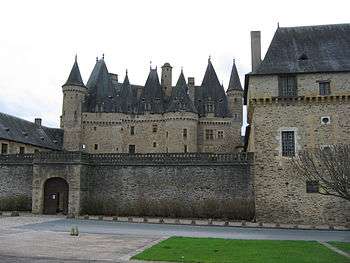Jumilhac-le-Grand
| Jumilhac-le-Grand | |
|---|---|
|
Château de Jumilhac | |
 Jumilhac-le-Grand | |
|
Location within Nouvelle-Aquitaine region  Jumilhac-le-Grand | |
| Coordinates: 45°29′41″N 1°03′51″E / 45.4947°N 1.0642°ECoordinates: 45°29′41″N 1°03′51″E / 45.4947°N 1.0642°E | |
| Country | France |
| Region | Nouvelle-Aquitaine |
| Department | Dordogne |
| Arrondissement | Nontron |
| Canton | Jumilhac-le-Grand |
| Intercommunality | Pays de Jumilhac-le-Grand |
| Government | |
| • Mayor (2008–2014) | Yves Congé |
| Area1 | 66.67 km2 (25.74 sq mi) |
| Population (2008)2 | 1,240 |
| • Density | 19/km2 (48/sq mi) |
| Time zone | CET (UTC+1) |
| • Summer (DST) | CEST (UTC+2) |
| INSEE/Postal code | 24218 / 24630 |
| Elevation |
186–442 m (610–1,450 ft) (avg. 274 m or 899 ft) |
|
1 French Land Register data, which excludes lakes, ponds, glaciers > 1 km² (0.386 sq mi or 247 acres) and river estuaries. 2 Population without double counting: residents of multiple communes (e.g., students and military personnel) only counted once. | |
Jumilhac-le-Grand is a commune in the Dordogne dėpartement in Nouvelle-Aquitaine in south western France.
The village lies on the road followed by Richard the Lionheart and on one of the many branches of the Camino de Santiago pilgrim route.
Jumilhac-le-Grand is a village of some 1,200 inhabitants in the northern part of the Dordogne. It is within the Périgord-Limousin Regional Nature Park, a protected area with a rich heritage. The landscape is one of hills and valleys and is perfectly suited to walks, bike-rides, and horseback riding. Its distinguishing features are green pastures with Limousin cows alternated by woods, orchards, rivers and lakes. In the rivers and lakes one can fish for trout as well as pike, perch and other coarse species.
The impressive 13th-century castle of Jumilhac is part of the Richard the Lionheart Route together with other neighbouring castles (Nexon, Coussac-Bonneval and Chalus).
Population
| Historical population | ||
|---|---|---|
| Year | Pop. | ±% |
| 1962 | 1,896 | — |
| 1968 | 1,654 | −12.8% |
| 1975 | 1,535 | −7.2% |
| 1982 | 1,411 | −8.1% |
| 1990 | 1,260 | −10.7% |
| 1999 | 1,215 | −3.6% |
| 2008 | 1,240 | +2.1% |
Sights
The Château de Jumilhac is classified as an historic building by the French Ministry of Culture.[1] The castle was at first a 12th-century feudal fortress that has been rebuilt and increased many times; most notably in the 17th century during the Renaissance, when new roofs were added that are unique in France. These roofs have enhanced the reputation of the castle, also known as the "Black Pearl" of the Green Périgord for its distinctive black ridge tiles.
See also
References
- ↑ Ministry of Culture Château de Jumilhac listing
External links
| Wikimedia Commons has media related to Jumilhac-le-Grand. |
